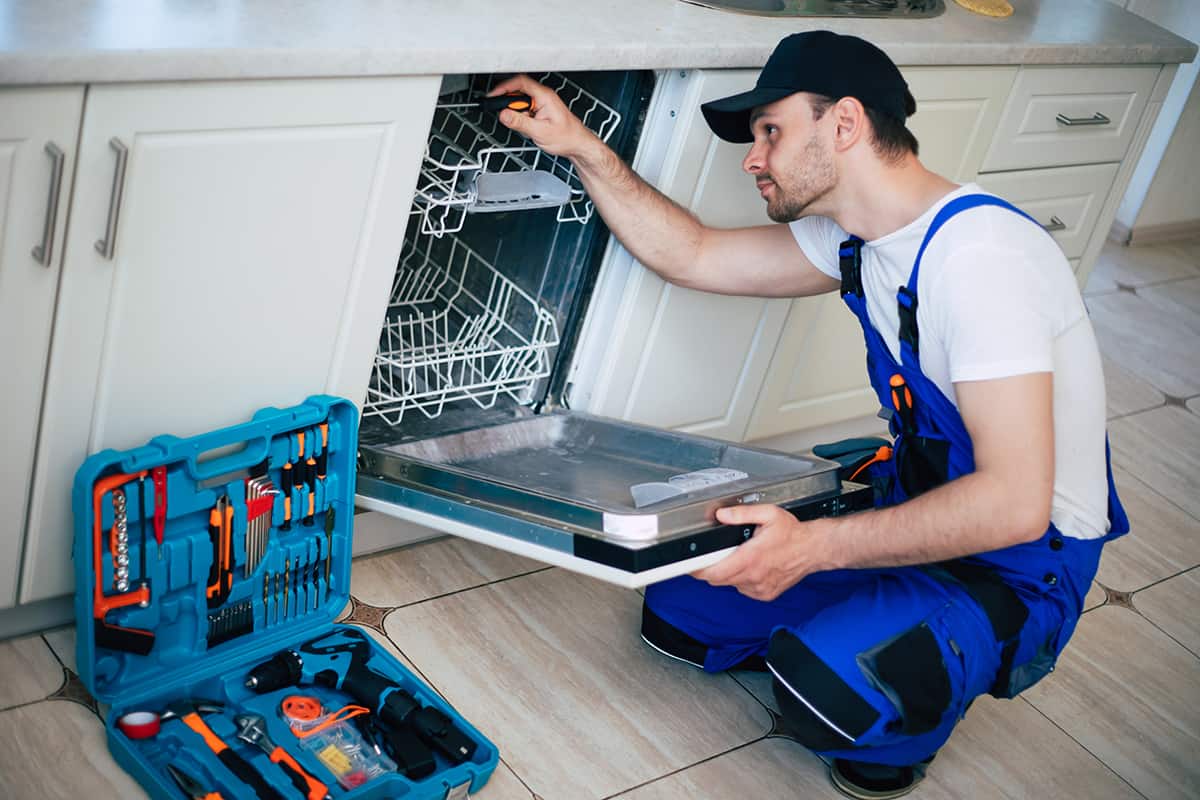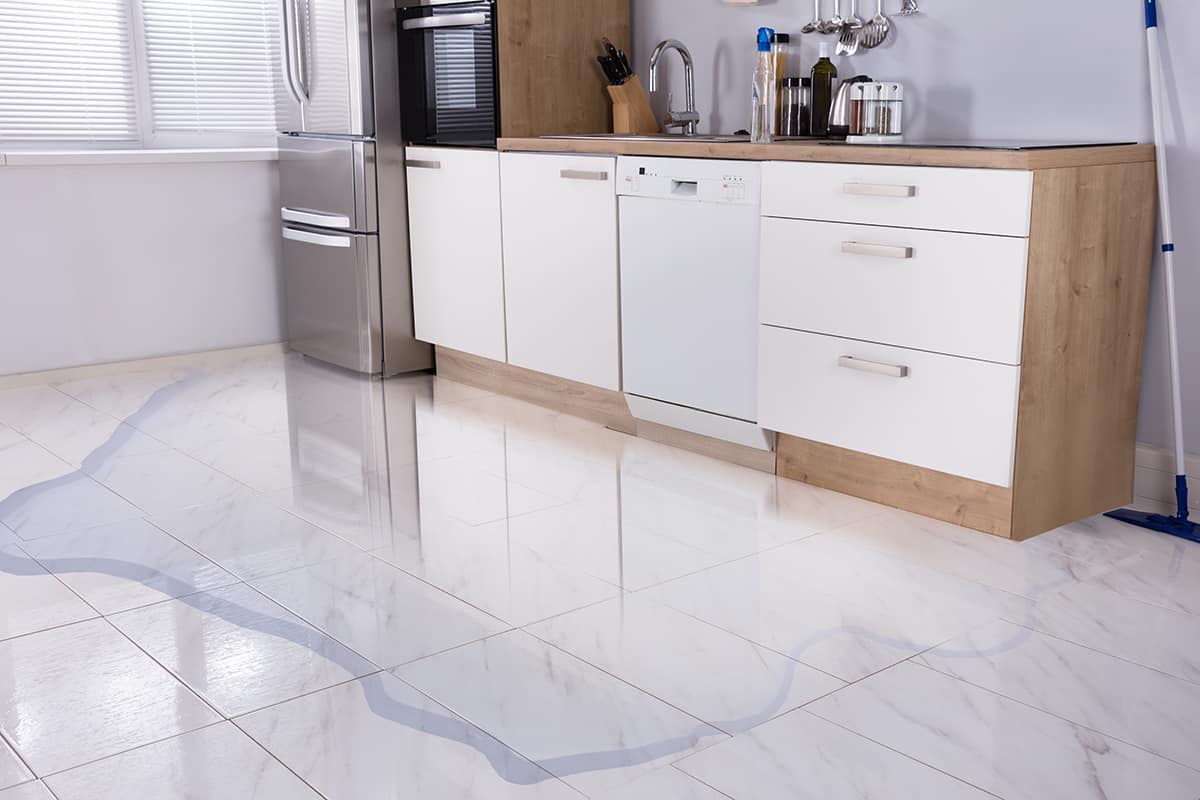Miele is known for being one of the most high-end home appliance manufacturers. Usually, products with a steeper upfront cost are of higher quality, but that doesn’t mean a Miele dishwasher won’t leak. So, why might your Miele dishwasher leak, and how do you fix it?
The most common causes of a leaking Miele dishwasher are a broken door gasket, an overfilled filter assembly, a faulty tablet dispenser door, and a faulty inlet valve. The solution may be to clean, fix, fasten, or even replace the faulty components.
In this guide, I’ll explain in greater detail which parts you need to examine for leaks, how to fix the leaking issue, and when it’s time to replace the Mile dishwasher completely.
Miele Dishwasher Leaks (Causes and Fixes)
Miele isn’t a magical brand that produces and distributes indestructible home appliances. However, one look at a Miele dishwasher’s price tag, and I’d completely understand why you might think otherwise. The fact of the matter is that Miele dishwashers, while incredibly high-end, are susceptible to common mechanical issues that may lead to leaking.
Earlier, I briefly mentioned the various causes and fixes behind a leaky Miele dishwasher. Now, allow me to explain those causes and their solutions in more detail down below.
1. Broken door gasket
Along the inside edge of the Miele dishwasher’s opening is a rubber gasket. The gasket is there to create a waterproof seal between the tub and the door. While the tub fills with water and the spray arms distribute soapy water to all dishracks, the gasket prevents water droplets from collecting on the door’s inner panel and spilling all over your kitchen floor. If you notice a puddle accumulating underneath the dishwasher’s door, you should inspect the door gasket.
Solution #1: Clean the gasket
Surprisingly, a quick clean will restore the gasket to good as new. All you need is a soft-bristled toothbrush to clean the gasket, making sure to clean the inner portion to remove solid debris that may stop the gasket from creating a waterproof seal.
Solution #2: Replace the gasket
In extreme cases, the gasket may have worn out. This can be due to not running the dishwasher frequently, thereby limiting how much moisture and lubricant the gasket gets. When the gasket has tears or cracked spots, you will need to replace it completely. This video by Absolute Appliance Services on YouTube will show you how to replace the door gasket on your Miele dishwasher.
2. Overfilled filter assembly
The filter assembly consists of 2 parts—a pre-filter for trapping large debris and a conical fine-mesh filter for straining finer debris. The filter prevents solids from entering the drain line, which could affect overall draining times.
Solution #1: Clean the filter assembly
Remove the filter assembly by twisting it counterclockwise. Take the filter assembly to your sink and dissemble it before dunking both parts into a bowl or basin of soapy water. Using a soft-bristle brush, gently scrub away all debris from the filter meshes before rinsing them, reassembling them, and reinstalling them inside your dishwasher.
Solution #2: Clean your garbage disposal
If the drain line is connected to your kitchen sink’s garbage disposal, clean out the garbage disposal. Let it run for 30 seconds before flushing water through your sink’s drain. If the water doesn’t drain quickly enough, disassemble the garbage disposal, clean it with soapy water, and use a chopstick or bamboo skewer to remove debris from the inlet and outlet lines.
3. Faulty tablet dispenser door
Modern Miele dishwashers come with a specialized compartment for detergent tablets. These tablets consist of a mix of dish detergent and rinse aid to leave your dishes absolutely sparkling after a full wash cycle. However, over time, the tablet dispenser door may not close entirely, which can lead to leaking.
Solution: Fix the tablet dispenser door
To fix the tablet dispenser door, look for a clip that keeps the door closed. If the clip is faulty, it may allow water to enter the door, which will then pour out of the dishwasher’s door and onto your floor. The clip can be repositioned or removed entirely to allow the door to shut completely. However, if you remove the clip, you will have to toss the tablets onto the bottom of the dishwasher tub.
4. Faulty inlet valve
The inlet valve supplies water from your water supply line to the dishwasher tub. Over time, water can erode the valve, creating tiny gaps that allow water to continuously pour into the machine, albeit at a trickle.
Solution: Replace the inlet valve
If your dishwasher continues to fill with water even when the door is open, this is a clear sign that the inlet valve is faulty. Unfortunately, the inlet valve of a Miele dishwasher is not fixable. You will need to pick up a replacement and install it on your own. You can gain access to the inlet valve by opening the back panel and looking for a copper or brass valve.
5. Damaged dishwasher tub
Although it’s totally rare, there could be a crack in the dishwasher’s tub. A crack can appear when dishes fall onto the tub or when the heating element is too close to the tub’s wall. Examine the surface of the dishwasher tub to locate the crack or tear.
Solution: Apply silicone caulk or epoxy putty to the crack
Carefully apply a coating of silicone caulk or epoxy putty to the crack on the dishwasher tub. Use a finger to push some of the filler into the crack and smoothen the surface. Let the filling agent dry before waiting 24-48 hours for it to cure completely.
Is It Worth Fixing a Leaking Dishwasher?

It depends on where the leak comes from. If the leak can be fixed by replacing the parts mentioned above, then yes, it is worth fixing.
However, if the drain pump—the part that is responsible for forcing dirty water out of the dishwasher—is faulty, then you might want to replace the dishwasher entirely, especially if your Miele dishwasher is over ten years old.
The thing about fixing a dishwasher, whether it’s leaking or one of the major components is defective, is that there’s no guarantee the problem will stop. Some users have found that it would cost them several hundred dollars to get their Miele dishwasher fixed, and in the end, it would run for just a few more years before the same problems would arise.
So, you do a cost-benefit analysis to determine whether or not patching up your old dishwasher is more cost-effective than replacing it with a newer, younger, hotter model.
Do I Need to Replace My Miele Dishwasher?
If none of the solutions above work, then there might be a problem with the drain pump. You can use a multimeter to look for continuity in the pump. If there’s a problem, you will need to order a new pump and replace it, but even then, that might not solve the problem.
Worst-case scenario, you will have to replace the dishwasher unit entirely. If your Miele dishwasher is over a decade old, it might be worth replacing your dishwasher.
Modern Miele dishwashers come with a specialized compartment for cutlery on the top dishrack, whereas older models came with a cutlery basket. While it might seem insignificant, users claim that the compartment is a lot more effective than the basket. The rinse aid actually gets between the spoons and forks a lot better than it does in the previous system.
There are also other significant upgrades in newer models. For instance, modern-day Miele dishwashers are a lot more resource-efficient than their predecessors. So, if you’re going to drop over a grand on a new dishwasher from Miele, you might be happy to learn that you’ll save a lot more on utility costs.
Of course, there is a huge benefit of going with a brand-new Miele. Most modern Miele dishwasher models are designed to last for up to 20 years or more. In fact, there are stories of people who are still using the same Miele dishwasher since the late 1990s. So, if you’re afraid of the upfront cost of a new Miele, don’t be—it’s an investment that will eventually pay for itself in energy bill savings.
With all that said, if it’s possible to patch your dishwasher up, then I suggest doing that. Of course, you can always swap out your old Miele for a new Bosch or KitchenAid!
Why Are Miele Dishwashers So Expensive?
The one thing that sets Miele apart from other household brands is quality. Sure, Bosch and KitchenAid are high-quality appliance manufacturers, but Miele is on a whole other level. From their canister vacuums to their dishwashers, Miele is almost always one step above its competitors.
Now, whether a Miele dishwasher is worth its price depends on the buyer. It might perform similarly to a Bosch, and it might be as sleek and attractive as a KitchenAid, but in the end, you can rest assured that your investment will eventually pay for itself in quality, reliability, and savings.






